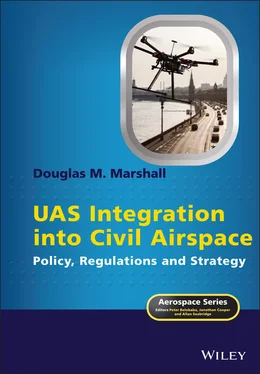The growth of this technology has outpaced the ability of governing authorities at all levels, international, national, regional and local, to keep up with the changes and promulgate rules, regulations, and standards for the operation of these systems in the public domain, namely the airspace above the surface. As a consequence, rogue operators and abusers of the technology have created havoc with their misuse of consumer drones to invade privacy, disrupt wildlife, interfere with firefighting and law enforcement activities, endanger manned aircraft operations around airports, and any number of irresponsible uses of affordable and readily available off-the-shelf drones. The need for safe and predictable environments for legitimate users of this technology is paramount, and airspace integration strategies are likely to offer the most achievable solutions.
This book will only briefly address the history of this technology, as many other publications have covered the same ground, but will provide a framework for understanding and evaluating just one critical element of this extremely complex environment: how to integrate these systems, large and small, fast and slow, heavy and light, all without pilots on board, with other occupants of the airspace, namely manned aviation, and how to do it safely, equitably, and efficiently to minimize the risk of disaster and maximize the economic opportunities sought by the users of the airspace. The full solution to the safe integration challenge, which has eluded the experts, developers, and regulators thus far, is the key to the further advancement of the technology beyond its current status. The ongoing global efforts characterize the potential solutions to this challenge as Unmanned Aircraft Traffic Management (UTM), or Unmanned Aircraft Systems Space (U-Space), or Advanced/Urban Air Mobility (AAM/UAM), depending upon in which part of the world the effort originates.
The following chapters will introduce the reader to the major issues confronting the developers of these strategies and provide a brief introduction to what each nation or group of nations is doing to address those issues. The templates adopted by the major contributors as they work their way through the often conflicting and sometimes overlapping regulatory environments in which they must operate to be successful are discussed in greater detail. There are many parallel efforts to identify a path to full integration of unmanned systems with manned aviation, and they do not all agree on the strategy or the architecture to make it so. For this reason, this book is unashamedly broad in scope in some respects and rather narrow in others. The goal is to identify a common way forward for the evolving UAS industry and the regulatory authorities that must enable and monitor its growth to ensure public safety and economic viability.
Chapter 1 “Background” introduces a thumbnail history of aviation regulations, derived in some respects from the ancient Law of the Sea. This chapter briefly summarizes the first attempts to regulate airplanes and their pilots in the UK, the creation of an international regulatory body (ICAO) in 1944 as a product of the Chicago Convention on International Civil Aviation, and then moves on to the present-day regulatory system, both national and international, that oversees all aspects of commercial and private aviation.
Chapter 2 “UAS Airspace Integration in the European Union” is a longer chapter, and attempts to cover historical and ongoing regulatory efforts in the European Union regarding unmanned aircraft operations and standards. The EU has been very busy adopting regulations for UAS that will apply across all of its Member States, and more recently embarked upon the concept of a “U-space” that is intended to integrate UAS/RPAS into the European airspace by establishing a new concept for how the airspace can be managed while not disrupting existing commercial and general aviation activities.
Chapter 3 “ICAO” covers the International Civil Aviation Organization and its airspace integration activities with specific focus on remotely piloted aircraft systems.
Chapter 4“UAS Airspace Integration in the United States” discusses airspace integration efforts in the United States, in coordination with Europe’s EASA and other national aviation authorities.
Chapter 5“Global Airspace Integration Activities” takes a look at UAS integration efforts in a few selected countries that are considered to be representative of similar efforts in a growing number of ICAO’s 193 Member States.
Chapter 6 “The Role of Standards” examines the role of Standards Development Organizations (SDOs) in the development of regulations and best practices.
Chapter 7 “The Technology” discusses the various domains of the evolving UAS and UTM/U-space technology, and includes suggestions for a methodologies for conducting a risk assessment and functional decomposition of complex systems. Chapter 8 “Cybersecurity and Cyber Resilience” offers a historical view of global cybersecurity failures and ties that history to current efforts to identify risks and defensive mechanism to ensure the security of aviation systems.
This is not an engineering text, nor is it a law book, but is a bit of a hybrid of both, focused on the study of one highly technical sector of innovation and economic growth from the proverbial “30,000 ft” view. The reader is cautioned, however, that the technology advances are extremely dynamic, and innovation, or “the next best thing,” is almost a daily occurrence, so that accurately predicting the future is a fool’s errand. As new challenges emerge, entrepreneurs and developers will step up to meet them, occasionally creating a new technology or new subset of existing technology that may not have existed even a year ago. The best we can do is to understand what is happening at this point in time and acquire the tools to respond to the breakneck pace of innovation in unmanned aircraft systems.
The field of aerospace is multidisciplinary, covering a large variety of products, disciplines and domains, not merely in design and engineering but in many related supporting activities. The interaction of these diverse components enables the aerospace industry to develop innovative and technologically advanced vehicles and systems. The Aerospace Series aims to be a practical, topical, and relevant series of books aimed at people working in the aerospace industry, including engineering professionals and operators, engineers in academia, and allied professions such as commercial and legal executives. The range of topics is intended to be wide ranging, covering design and development, manufacture, operation and support of aircraft, as well as infrastructure operations and advances in research and technology.
Unmanned air vehicles are a growing and increasingly accepted part of the aerospace environment. Small UAVs equipped with appropriate sensors can carry out leisure, small industry and official roles in the visible and IR spectrum. As their use expands, unmanned air systems will inevitably become involved with, and potentially conflict with, manned vehicles – as has already been demonstrated by numerous encounters near airports. There will need to be new regulations to allow the co-existence of UAVs with GAS, rotary wing, regional and transnational operations. These new regulations could require changes to on-board navigation and proximity warning systems as well as to ATM practices and standards.
This book – UAS Integration into Civil Aerospace – explores the integration of unmanned aircraft into controlled and uncontrolled airspace. It provides a comprehensive overview of regulatory and policy efforts required to move towards full airspace integration, as well as the technology that must be developed and approved for full operation of UAV systems. It also addresses the critical questions of cybersecurity and cyber resilience as they relate to UAV airspace integration. The global ATM system depends heavily on electronic communications and interconnectivity, any interruption of which could lead to potentially catastrophic consequences.
Читать дальше












